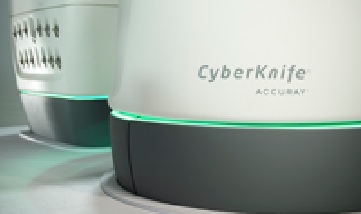
October 3, 2013 — Accuray Incorporated announced that studies presented at the American Society for Radiation Oncology (ASTRO) 55th Annual Meeting continue to reinforce evidence of clinical and quality of life benefits for the CyberKnife and TomoTherapy Systems.
Cyberknife Clinical and Technical Study
The 43 CyberKnife presentations focused on a range of indications including lung, brain, kidney, and prostate stereotactic body radiation therapy (SBRT), which was the topic of 14 presentations. The emphasis on CyberKnife prostate SBRT was timely, given ASTRO’s recently announced update to its model policy on SBRT which states that SBRT is an appropriate alternative for select patients with low to intermediate risk disease.
Two[i] prospective Phase II studies found that the quality of life for patients undergoing CyberKnife SBRT for prostate cancer “compare favorably to published results from radical prostatectomy and intensity-modulated radiation therapy.”
One[ii] study of lung SBRT with the CyberKnife System reported lower chest wall maximum dose when lesions were tracked with the Synchrony Respiratory Tracking System compared to static or linac-based treatment plans, and another study[iii] showed very low incidence of chest wall pain, a common side effect of lung SBRT for lesions near the chest wall.
Three[iv] treatment planning simulation studies incorporating the multileaf collimator of the new CyberKnife M6 System found consistent reductions in treatment time for both radiosurgery and intensity-modulated radiation therapy (IMRT) plans, with equivalent or improved plan quality relative to the prior circular collimator plans or IMRT plans generated for other radiotherapy systems.
TomoTherapy Clinical and Technical Study
Of the 61 TomoTherapy presentations, several focused on treatment of breast, head and neck, prostate and lung cancers. The studies showed the breadth and depth of the TomoTherapy system as an efficient treatment option for a wide range of patients and disease types clinically proven to provide strong disease control and low incidence of toxicity.
One[v] notable study showed TomoDirect can be used to deliver hypofractionated whole breast radiotherapy with a simultaneous boost to the resection cavity. Authors concluded TomoDirect was, “…an efficient means to deliver accelerated hypofractionated [treatment]...with an optimal dose distribution, negligible toxicity and encouraging clinical results.”
Another study[vi] presented long-term outcomes of post-operative helical TomoTherapy treatment of malignant pleural mesothelioma. Overall survival was “among the best observed in recent studies, supporting the idea that this approach represents an alternative option to extrapleural pneumonectomy.”
In a related study[vii], authors confirmed in patients with malignant pleural mesothelioma that either adjuvant conventionally fractionated or definitive hypofractionated TomoTherapy treatment results in a high prescription dose to the treatment volume while sparing organs at risk.
A third study[viii] showed that use of VoLO planning, the GPU-based dose calculation system, results in “a considerable saving of time during the calculation process” without significant changes in plan quality.
For more information: www.accuray.com
References:
[i] Chen et al., Quality of Life (QOL) Outcomes Through 3 Years After Stereotactic Body Radiation Therapy (SBRT) for Early Prostate Cancer: Results From a Multi-institutional Phase 2 Trial. 55th Annual American Society for Radiation Oncology (ASTRO) Meeting, Atlanta, Georgia, September 22 – 25, 2013. Meier et al., Patient-Reported Quality of Life Outcomes in Intermediate-Risk Prostate Cancer Patients Treated With Stereotactic Body Radiation Therapy. 55th Annual American Society for Radiation Oncology (ASTRO) Meeting, Atlanta, Georgia, September 22 – 25, 2013.
[ii] Goldin et al., Stereotactic Body Radiation Therapy for Early Stage Lung Cancer: Quantifying the Effect of Tracking With Respiratory Motion on Chest Wall Dosimetry. 55th Annual American Society for Radiation Oncology (ASTRO) Meeting, Atlanta, Georgia, September 22 – 25, 2013.
[iii] Podder et al., Chest Wall and Rib Irradiation of Lung Cancer Patients Treated With Robotic Radiosurgery SBRT. 55th Annual American Society for Radiation Oncology (ASTRO) Meeting, Atlanta, Georgia, September 22 – 25, 2013.
[iv] Kole et al. Improved Normal Tissue Sparing and Reduced Treatment Time Using Multileaf Collimator Robotic Radiosurgery Stereotactic Body Radiation Therapy (SBRT) Compared to Iris Collimator SBRT in Treatment of Localized Prostate Cancer. 55th Annual American Society for Radiation Oncology (ASTRO) Meeting, Atlanta, Georgia, September 22 – 25, 2013. Wang et al. Beam Selection for MLC-Based Robotic Radiation Therapy. 55th Annual American Society for Radiation Oncology (ASTRO) Meeting, Atlanta, Georgia, September 22 – 25, 2013. McGuinness et al., Standard Fractionation IMRT With a MLC-Equipped Robotic Radiosurgery System. 55th Annual American Society for Radiation Oncology (ASTRO) Meeting, Atlanta, Georgia, September 22 – 25, 2013.
[v] Franco et al., Hypofractionated Adjuvant Breast Radiation and Simultaneous Integrated Boost Delivered With Static Angle Tomotherapy: A Prospective Phase 2 Trial. 55th Annual American Society for Radiation Oncology (ASTRO) Meeting, Atlanta, Georgia, September 22 – 25, 2013.
[vi] Trovo et al., Radical Pleurectomy/Decortication Followed by High Dose of Radiation Therapy Delivered With Tomotherapy for Malignant Pleural Mesothelioma: Final Results With Long-term Follow-up. 55th Annual American Society for Radiation Oncology (ASTRO) Meeting, Atlanta, Georgia, September 22 – 25, 2013.
[vii] Parisi et al. Tomotherapy in the Treatment of Malignant Pleural Mesothelioma. 55th Annual American Society for Radiation Oncology (ASTRO) Meeting, Atlanta, Georgia, September 22 – 25, 2013.
[viii] Mohr et al., Accelerated GPU-Based Tomotherapy Planning. 55th Annual American Society for Radiation Oncology (ASTRO) Meeting, Atlanta, Georgia, September 22 – 25, 2013.


 December 11, 2025
December 11, 2025 









